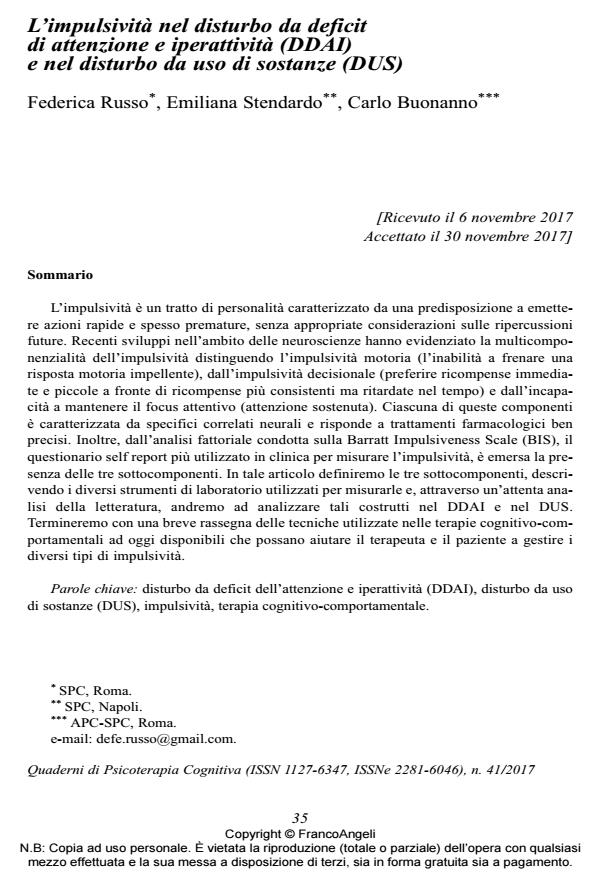Impulsivity in Attention Deficit Hyperactivity Disorder (ADHD) and in the Substance Use Disorder (SUD)
Journal title QUADERNI DI PSICOTERAPIA COGNITIVA
Author/s Federica Russo, Emiliana Stendardo, Carlo Buonanno
Publishing Year 2017 Issue 2017/41
Language Italian Pages 17 P. 35-51 File size 120 KB
DOI 10.3280/QPC2017-041003
DOI is like a bar code for intellectual property: to have more infomation
click here
Below, you can see the article first page
If you want to buy this article in PDF format, you can do it, following the instructions to buy download credits

FrancoAngeli is member of Publishers International Linking Association, Inc (PILA), a not-for-profit association which run the CrossRef service enabling links to and from online scholarly content.
Impulsivity is a personality trait characterised by a predisposition to emit rapid and prepotent action without foresight. Recent developments in the field of neuroscience have high-lighted the multidimensional nature of impulsivity distinguishing among motoric forms of impulsivity (the inability to withhold from making a response), decisional impulsivity (the preference for small, immediate rewards versus larger but delayed rewards) and the inability to keep the attentional focus (sustained attention). Each component is characterized by different neural networks responding to different pharmacological treatments. Moreover, the factor analysis applied on the Barratt Impulsiveness Scale (BIS), the self report questionnaire more widely used in the clinical field, has shown the presence of three subscales each corresponding to the three subcomponents of impulsivity. In the present article we will define the three subcomponents of impulsivity, describing the different laboratory paradigms used to assess them and, through an accurate analysis of the scientific literature we will analyse them in the ADHD and in the SUD. We will end with a short list of treatments available in the present cognitive behavioural therapy which can help manage the different forms of im-pulsivity.
Keywords: Attention Deficit Hyperactivity Disorder (ADHD), Substance Use Disorder (SUD), impulsivity, cognitive behavioral therapy.
Federica Russo, Emiliana Stendardo, Carlo Buonanno, L’impulsività nel disturbo da deficit di attenzione e iperattività (DDAI) e nel disturbo da uso di sostanze (DUS) in "QUADERNI DI PSICOTERAPIA COGNITIVA" 41/2017, pp 35-51, DOI: 10.3280/QPC2017-041003